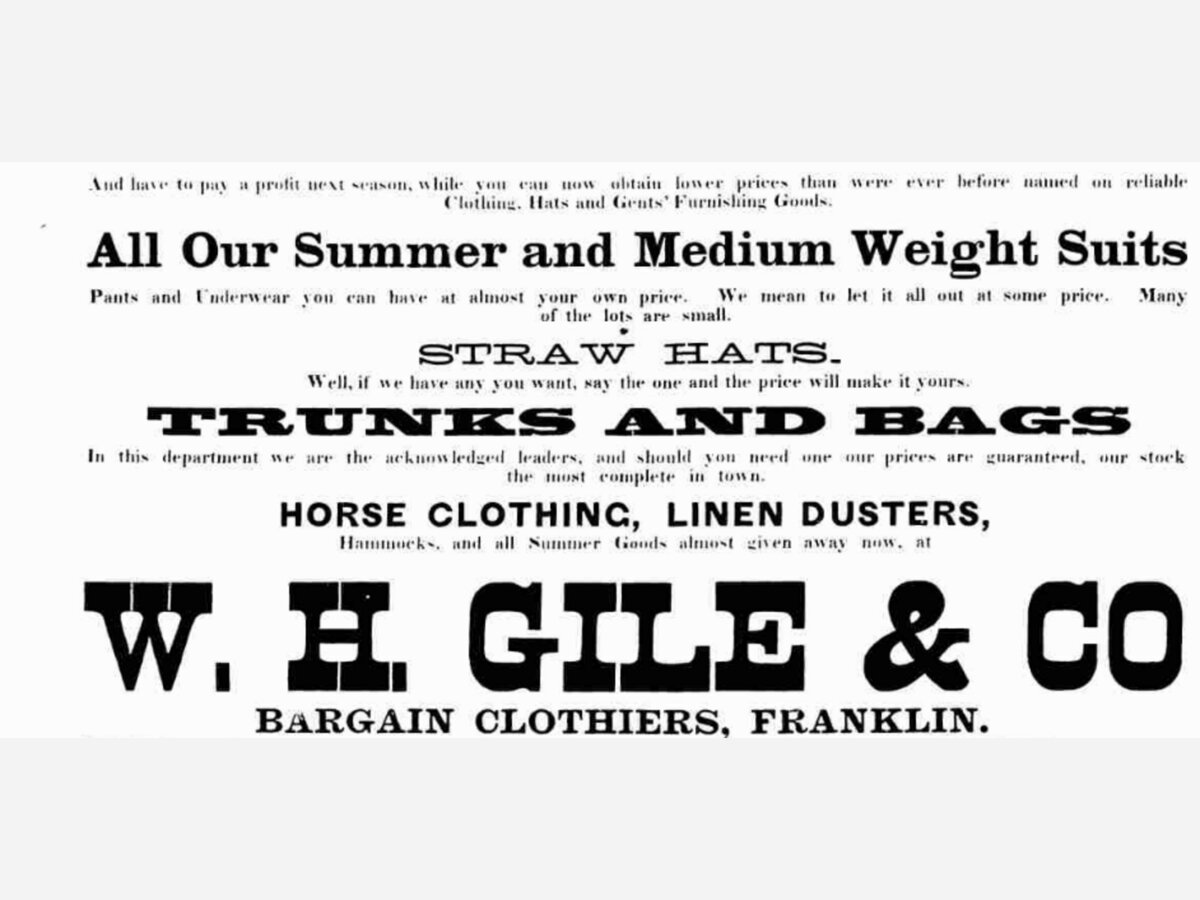Image


There are a number of competing origin stories for Labor Day in the US, but all point to the labor movement as the common element. In 1887, the holiday began to be fully accepted when Oregon became the first state to recognize it. Massachusetts followed that same year. As many as 30 states recognized the holiday by 1894, in which year Congress made it a federal holiday (though only federal workers could claim it as a day off from work).
Franklin’s involvement with the holiday, at least based on reporting in the Franklin Sentinel newspaper, accords it hardly a mention at all until 1889, but thereafter, it quickly became a real event, with recreational activities – and even Labor Day sales by local merchants.
Sept 3, 1887, merely noted “Labor Day is next Monday,” The next year was equally terse but for a large ad, part of which is shown above, captioned “LABOR DAY – Give the New Holiday an Immense Boost.”
But when 1890 arrive, Franklin and vicinity were fired up and making the most of the day. A front-page Sentinel story provides the facts and the color...
* * * * *
LABOR DAY
A Glorious Day Enjoyed by Thousands of People
Monday, Labor Day, was generally observed in this vicinity as a holiday and in the afternoon, business of all kinds was generally suspended. The weather was all that could be desired for enjoyment out of doors, the sun shining brightly and the air cool and bracing
At Lake Pearl
A programme of sports was arranged under the direction of Prof. B. Sweet of Providence, RI.I., which afforded much interesting excitement.
In the dining hall an excellent clam dinner was served and also supper, and although extensive preparation had been made in this department, while there was plenty of good things for those to partook of the dinner, later in the day the rush was so large that the larder was exhausted. Through the day, the company was a large one, but after 4 pm, hundreds more came in until one of the largest crowds ever seen on the ground was gathered. The dancing floor was crowded with patrons of that amusement and all of the attractive features of the park were kept in a rush. In the morning the Wrentham band gave a good concert and furnished pleasing music during the day.
In addition to the dramatic entertainments in the Amphitheatre and other amusements, the following races were carried out:
Bicycle races – 3.20 class, ordinaries, distance 1 mile; Bert Hedges, 3.27; C. Young, 3.38 1-5.
One mile, safeties – Monte Scott, 3.28; Bert Hedges, 3.40.
Messrs. Arnold H. Heilborn and Thomas Richards of Providences, R.I., accomplished the feat of swimming a mile, walking a mile, running a mile and riding a broncho bicycle a mile inside of one hour.
Heilborn took first prize, gold watch, time 54.9 3-5; Richards, second prize, and elegant silver medal, time 54.15
At Indian Rock Park
A large crowd gathered in the afternoon to see the race for a purse of $200, best three in five, mile heats, between horses owned by Richard DeWier, Albert Frink, George S. Ryan and Charles W. Hill. Frink won the race in three straight heats without much hard work; time 2.57 1-2, 2.58, 2.54 3-4.
At Woodland Park
The union picnic of the West Medway brass band, Knights of Labor and Lasters’ Protective Union was attended by 800 people. The ball game between the South Walpoles and the Alerts of Medway was won by the former, 13 to 9.
In the running high jump, J.J. Gary of South Walpole, jumped 4 feet 9 inches, defeating Charles P. O’Hara of Medway, his only competitor.
O’Hara, on a running hop, step, and jump, covered 39 feet 3 inches and Gary, 32 feet 2 inches.
Gary, in three standing jumps, covered 34 feet 8 inches, and O’Hara 32 11 inches.
The event of the day was a 135- yard handicap running race in which there were 15 entries, but only eight starters, the race being run in heats. Thomas F. Gary of South Walpole beat P. Kennedy of Franklin; M. Coughlin of Franklin beat J.J. Gary of South Walpole; Arthur Haley of West Medway beat D. Shea of North Bellingham, and Patrick Lyons of West Medway beat Maurice Fitzpatrick of North Bellingham. In the final heat for winners in the foregoing, Lyons took the first prize, Coughlin second, and Thomas F. Gary third.
In the clay bird shoot there were seven entries who, with their scores were as follows: Almond Smith and Everett Burrell, 16 each in a possible 20; Matthew F. Desmond and John Clancy, 13 each; Harry J. Bell and John Sanger, 12 each; Frank Clancy, 6.
Knowlton and Allen’s orchestra of Natick furnished music for dancing, which was free during the day.
The gate receipts were in the vicinity of $300, and the net profits will be about $400.
NOTES: Woodland Park was largely in Franklin but was reached via a bridge across the Charles from West Medway and was, effectively, part of that community. The unfamiliar bicycle types mentioned include ordinaries (commonly known today as ‘high-wheelers’ or penny-farthings in the UK), safeties,(a more familiar type roughly resembling modern bicycles, with pedals linked to the rear wheel by a chain), and broncho (similar to the safety bike but with the pedals directly attached to the rear wheel).